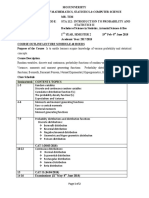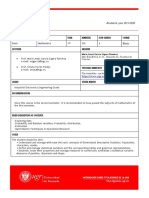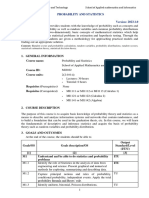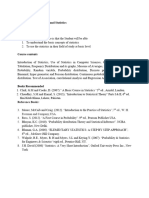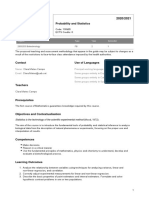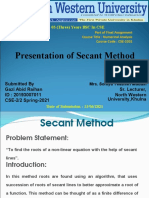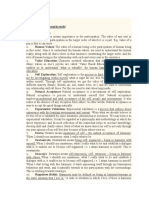Course Description_MAS 102
Uploaded by
petersarikazCourse Description_MAS 102
Uploaded by
petersarikazMAS 102: Probability and Distribution Theory I
Credit hours: 3
Lecture hours: 42
Contact hours: 45
Pre-requisite: MAS 103
Purpose of the Course
To deepen learners’ understanding of probability theory and bivariate distributions, so that they are able to analyze
relationships between variables.
Expected Learning Outcomes of the Course
By the end of this course, learners will be able to:
a) apply concepts from special continuous distributions to model and interpret real-world scenarios.
b) analyze and interpret bivariate distributions, including marginal and conditional probabilities and stochastic
independence.
c) derive distributions of functions of random variables.
d) utilize statistical software to model and visualize relationships between variables effectively.
Course Content
Review of probability theory: Review of MAS 103; Special Continuous Distributions: Gamma, Use of Incomplete
gamma tables, Chi-square, Weibull, Beta, Cauchy; Bivariate probability distributions: The joint probability law,
marginal and conditional distributions, stochastic independence, conditional expectations and regression. The
Bivariate normal distribution: Distribution of functions of two random variables: The distribution function technique,
moment generating function technique, variable transformation technique.
Instructional Methods
Interactive lectures, hands-on software-based practical sessions, group discussions, and problem solving exercises.
Instructional Materials and/or Equipment
Lecture notes, statistical software, computers or laptops, projectors, and curated datasets.
Learner Assessment at Course Level
The course shall be assessed through formative and summative assessments. The distribution of marks will be as
follows:
a) Formative assessment (Continuous Assessment Test) accounting for 30%.
b) Summative assessment (End of Semester Examination) accounting for 70%.
Core Reading Materials for the Course
1. Morris H DeGroot & Mark J Schervish (2012), Probability and Statistics; 4th Edition, Pearson Education, Inc.
ISBN 978-0-321-50046-5.
2. Robert V Hogg & Allen T Craig (2004) Introduction to Mathematical Statistics; 5th Edition, Pearson Education,
Inc. ISBN 13: 9780023557224.
Recommended Reference Materials for the Course
1. S C Gupta & V K Kapoor (2000), Fundamentals of Mathematical Statistics (A Modern Approach); 10th Edition,
Sultan Chand & Sons. ISBN 81-7014-791-3.
2. Jay L Devore & Kenneth N Berk (2012), Modern Mathematical Statistics with Applications 2nd Edition, Springer
Texts in Statistics. ISBN 978-1-4614-0390-6.
3. William Mendenhall, III, Robert J Beaver & Barbara M Beaver (2013), Introduction to Probability and Statistics
14th Edition, Brooks/Cole Cengage Learning. ISBN: 1-133-10375-8.
You might also like
- STA 112 INTRODUCTION TO PROBABILITY AND STATISTICS II Course OutlineNo ratings yetSTA 112 INTRODUCTION TO PROBABILITY AND STATISTICS II Course Outline2 pages
- Official Undergraduate Course Outline FormNo ratings yetOfficial Undergraduate Course Outline Form2 pages
- Course Outline Probability and StatisticsNo ratings yetCourse Outline Probability and Statistics4 pages
- Mathematics-II (Probability & Statistics) - Course OultineNo ratings yetMathematics-II (Probability & Statistics) - Course Oultine2 pages
- 2024_MI2022_Probability-and-Statistics_ICT_FinalNo ratings yet2024_MI2022_Probability-and-Statistics_ICT_Final7 pages
- MI2036 ProbabilityStatisticsRandomSignalProcess CTTT Final 2024.2No ratings yetMI2036 ProbabilityStatisticsRandomSignalProcess CTTT Final 2024.25 pages
- Probability and Statistics - II - SMS - 3200 - Course - OutlineNo ratings yetProbability and Statistics - II - SMS - 3200 - Course - Outline2 pages
- 1probability and Statistics For Pre-Engineers Course OutlineNo ratings yet1probability and Statistics For Pre-Engineers Course Outline3 pages
- MAT 211 CourseGuide - Lecture Notes - Summer 2015No ratings yetMAT 211 CourseGuide - Lecture Notes - Summer 201579 pages
- Syllabus - Stats 412 - Miller-Fink - W21No ratings yetSyllabus - Stats 412 - Miller-Fink - W2113 pages
- Probability and Statistics: MCA 4020 B1779No ratings yetProbability and Statistics: MCA 4020 B177910 pages
- MI2023E Probability and Statistics CTTT Final 2024.2No ratings yetMI2023E Probability and Statistics CTTT Final 2024.28 pages
- PROBABILITY AND STOCHASTIC PROCESSES - 2023 Course OutlineNo ratings yetPROBABILITY AND STOCHASTIC PROCESSES - 2023 Course Outline2 pages
- Probability and Statistics (MTS-PST-311) Module Details_080751No ratings yetProbability and Statistics (MTS-PST-311) Module Details_0807519 pages
- 2024 MI2020E Probability-and-Statistics CTTT Final 2No ratings yet2024 MI2020E Probability-and-Statistics CTTT Final 27 pages
- UG B.SC (STATISTICS) ) I YEAR SYLLABUS 2019No ratings yetUG B.SC (STATISTICS) ) I YEAR SYLLABUS 201910 pages
- MA8391 Probability and Statistics PagenumberNo ratings yetMA8391 Probability and Statistics Pagenumber66 pages
- Course Outline - Probability and Statistics For Engineers (ES 202)No ratings yetCourse Outline - Probability and Statistics For Engineers (ES 202)3 pages
- Mixed Methods Research: Applying AI Tools for Effective Writing and PublishingFrom EverandMixed Methods Research: Applying AI Tools for Effective Writing and PublishingNo ratings yet
- Myofascial Trigger Points: The Current Evidence: Leesa K. HugueninNo ratings yetMyofascial Trigger Points: The Current Evidence: Leesa K. Huguenin11 pages
- Topic 1 - Introduction of Production and Operation ManagementNo ratings yetTopic 1 - Introduction of Production and Operation Management16 pages
- Consortium of National Law Universities: Provisional 4th List - CLAT 2022 - UGNo ratings yetConsortium of National Law Universities: Provisional 4th List - CLAT 2022 - UG6 pages
- Honey Powder Extract - LC-232267 - HC - He - F - 2023 - O2267No ratings yetHoney Powder Extract - LC-232267 - HC - He - F - 2023 - O22672 pages
- ID-20193007011 Presentation of Secant MethodNo ratings yetID-20193007011 Presentation of Secant Method18 pages
- Road Curve Superelevation Design: Current Practices and Proposed ApproachNo ratings yetRoad Curve Superelevation Design: Current Practices and Proposed Approach12 pages
- International Journal of Solids and Structures: L. Wu, L. Noels, L. Adam, I. DoghriNo ratings yetInternational Journal of Solids and Structures: L. Wu, L. Noels, L. Adam, I. Doghri18 pages
- Business Negotiations - Unit 1 - Business Negotiations Week-1 QUIZ ANSWERSNo ratings yetBusiness Negotiations - Unit 1 - Business Negotiations Week-1 QUIZ ANSWERS3 pages
- Industrial Engineering Question Paper 2023No ratings yetIndustrial Engineering Question Paper 20232 pages
- Saving The Earth Starts With You: Care For God'S CreationNo ratings yetSaving The Earth Starts With You: Care For God'S Creation13 pages
